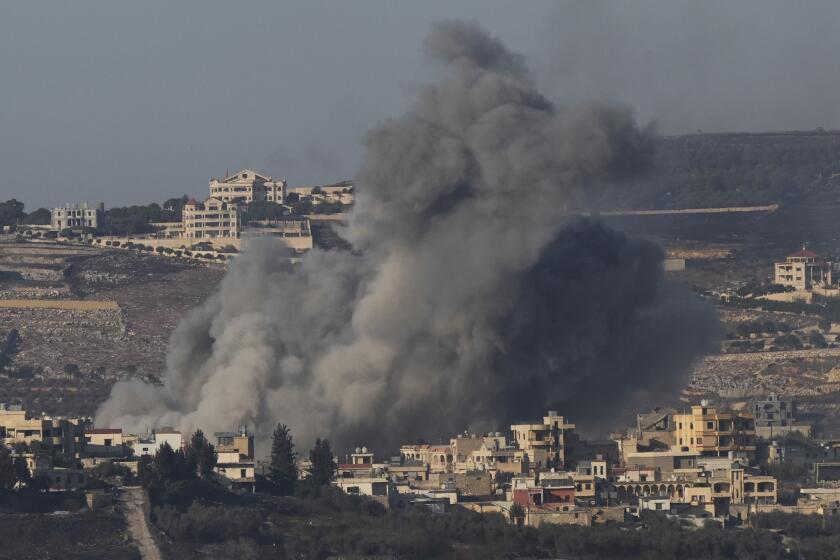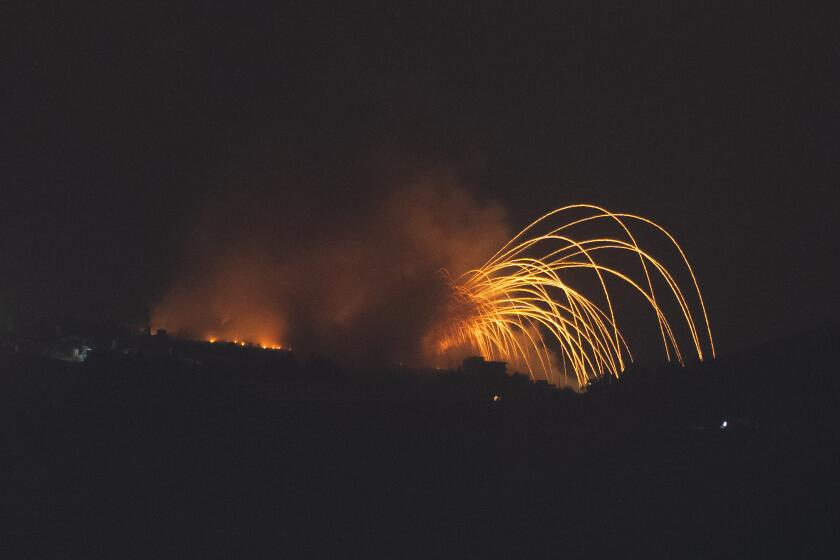Hezbollah steps up rocket fire into Israel, which sends more troops into Lebanon

- Share via
BEIRUT — Hezbollah fired a barrage of rockets into Israel on Tuesday, and the militant group’s acting leader vowed to keep up pressure that has forced tens of thousands of Israelis from their homes near the Lebanese border. The Israeli military said that it sent more ground troops into southern Lebanon and that a senior Hezbollah commander was killed in an airstrike.
Dozens of rockets fired by Hezbollah were aimed as far south as Haifa, and the Israeli government warned residents to the north of the coastal city to limit activities, prompting the closure of more schools. The Israeli military said Hezbollah launched more than 170 rockets across the border.
Sheikh Naim Kassem, the acting leader of Hezbollah, said its military capabilities are still intact after weeks of heavy Israeli airstrikes and attacks that killed its top commanders in a matter of days.
Christian villages in southern Lebanon thought their neutrality may spare them from violence in the Israel-Hezbollah conflict. Then the evacuation orders came.
Kassem said Israeli forces have not been able to advance since launching a ground incursion into Lebanon last week. The Israeli military said Tuesday that it deployed a fourth division, and that operations have expanded to the west, but its focus still appears to be a narrow strip along the border.
The Israeli military said it has dismantled militant infrastructure along the border and killed hundreds of Hezbollah fighters. On Tuesday, it said a strike in Beirut had killed Suhail Husseini, whom it described as a senior commander responsible for overseeing logistics, budget and management of the militant group.
There was no immediate comment from Hezbollah, and no way to confirm battlefield claims made by either side.
Israeli forces also fought heavy battles Tuesday with Palestinian militants in northern Gaza, where residents were ordered in recent days to evacuate.
Hezbollah appears outmaneuvered by a technologically superior foe that has assassinated much of its top leadership and destroyed a significant portion of its weapons.
Hezbollah launches more than 170 rockets
Kassem, speaking by video from an undisclosed location, said: “We are firing hundreds of rockets and dozens of drones. A large number of settlements and cities are under the fire of the resistance.”
He said Hezbollah will name a new leader to succeed Hassan Nasrallah, who was killed in an Israeli airstrike in a bunker in Beirut last month, “but the circumstances are difficult because of the war.”
Kassem said Hezbollah backs efforts by Lebanon’s parliament Speaker Nabih Berri to reach a cease-fire, but did not specify whether that means the group would be willing to accept a truce before there is a cease-fire in Gaza. Berri, a close ally of Hezbollah, has been seen as the main interlocutor between the militant group and the United States, and has been trying to broker a cease-fire since fighting began a year ago.
The conflict between U.S.-backed Israel and Iran-backed Hezbollah could reach unprecedented levels of danger and destruction if it becomes all-out war.
The Israeli army said 170 projectiles were launched from Lebanon toward northern Israel on Tuesday, and that its aerial defense intercepted most of them. A 70-year-old woman was wounded by shrapnel and Israeli media aired video of what appeared to be minor damage to buildings near Haifa.
The military also said it struck Hezbollah targets in the southern Beirut suburbs, where the militant group is headquartered.
Hezbollah began firing rockets into northern Israel on Oct. 8, 2023, the day after Hamas’ surprise attack into Israel ignited the war in Gaza. Hezbollah and Hamas are both allied with Iran.
Israel says it will keep fighting until residents in the north can go home
Israel has inflicted a punishing wave of blows against Hezbollah in recent weeks and says it will keep fighting until tens of thousands of displaced Israeli citizens can return to their homes in the north.
Israel’s assassination of Hezbollah leader Hassan Nasrallah set off furious grief or grim satisfaction, redoubling fears of a widening regional war.
More than 1,300 people have been killed in Lebanon and over a million displaced since the fighting escalated in mid-September.
Since then, Hezbollah has extended its rocket fire into central Israel, setting off air raid sirens in Tel Aviv. Iran-backed Houthi rebels in Yemen have also launched missiles that reached central Israel. Most of the projectiles have been intercepted or fallen in open areas, disrupting life in Israel while causing few casualties and little property damage.
Last week, Iran launched its own barrage of some 180 ballistic missiles at Israel, in what it said was a response to the killing of Nasrallah, an Iranian general who was with him at the time and Ismail Haniyeh, the top leader of Hamas, who was killed in an explosion in Iran’s capital in July.
Israel has vowed to respond to the missile attack, without saying when or how.
Israeli Defense Minister Yoav Gallant is in Washington this week to meet with Defense Secretary Lloyd J. Austin III. The Biden administration says it is opposed to an Israeli attack on Iran’s nuclear facilities, which could escalate regional tensions even further.
Hassan Nasrallah propelled Hezbollah in Lebanon into one of the world’s most powerful paramilitary factions and Israel’s constant foe.
Heavy fighting and evacuation orders in Gaza
Northern Gaza, where heavy fighting raged Tuesday, was the first target of Israel’s ground offensive. Entire neighborhoods have been reduced to rubble and Israeli troops have largely isolated the region — which includes Gaza City — since last October, when up to a million people fled to the south following Israeli evacuation orders.
Hundreds of thousands have remained in the north despite the harsh conditions, leading Israel to order another total evacuation in recent days. Israel has barred residents from returning to the north.
Israeli forces are battling Hamas militants in Jabaliya, a densely populated urban refugee camp dating back to the 1948 war surrounding Israel’s creation. Palestinian residents said Israeli warplanes and artillery were pounding Jabaliya as well as Beit Hanoun and Beit Lahiya, towns near the border.
On his account on the social media platform X, Avichay Adraee, a spokesman for the Israeli military, posted a renewed order for people in Jabaliya to leave and move southward, saying the military would soon “operate strongly” on the ground and from the air in the area.
Israel says the militant group’s headquarters is located under residential buildings in Beirut suburb, which were hit.
The Israeli military said it killed about 20 militants in airstrikes and ground fighting in Jabaliya. It said troops located a large quantity of weapons, including grenades and rifles.
The nearby Kamal Adwan Hospital said at least 15 people, including two women and four children, were killed Tuesday in the fighting in Jabaliya. It said the dead included four people who were trying to retrieve bodies.
“The situation is extremely difficult. The bombing and explosions haven’t stopped,” said Mahmoud Abu Shehatah, a Jabaliya resident. “It’s like the first days of the war.”
The war began when Hamas-led militants stormed into southern Israel on Oct. 7, 2023, killing some 1,200 people, mostly civilians, and abducting around 250.
Israel’s retaliatory offensive has killed around 42,000 Palestinians, according to local health authorities. They do not say how many were fighters, but say women and children make up at least half of all fatalities.
Mroue and Goldenberg write for the Associated Press. Goldenberg reported from Jerusalem. Associated Press writer Samy Magdy in Cairo contributed to this report.
More to Read
Sign up for Essential California
The most important California stories and recommendations in your inbox every morning.
You may occasionally receive promotional content from the Los Angeles Times.
















